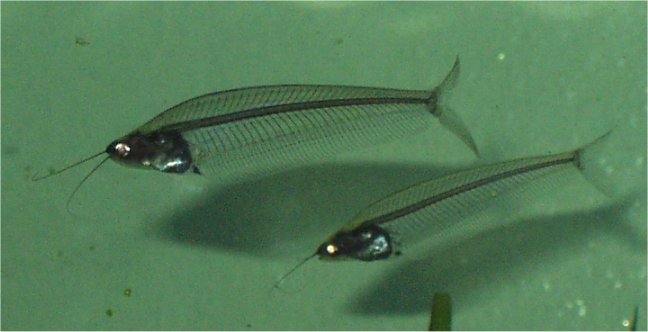
Glass Catfish
Other names: Kryptopterus bicirrhis (scientific)
Ghost Catfish
Ghost Fish
Thailand Glass Catfish
Origin: South East Asia
Thailand
Malaysia
Indonesia
Eastern India
This fish has a unique body form, the whole fish is transparent. Bones are clearly seen throughout the muscle strands, as are the organs which are compressed and contained in a silvery blue sac, just behind the eyes. Although their eyes are considered by some to be cute, this fish has very poor eyesight. They detect food and or danger by utilizing the "whiskers" or "feelers" , located near their mouths. They have been reported to grow anywhere from two and a half inches to eight inches long. It's head and body make up less than 20% of its total size. Upon maturity, a small pink patch will appear on the operculum. The dorsal fin consists of one single hard ray, while the anal fin is particularly long, and runs from the anal opening to the base of the caudal fin, the ladder is deeply forked.
It is also unique in the fact that it does not behave as a normal catfish would. They do not forrage from the bottom of the tank, preferring instead, to remain at the top or midway point of the aquarium. They are not nocturnal as most catfish are and rather enjoy basking in gentle currents. They are like their cousins in the fact that they prefer well planted and decorated habitats. Rocks and driftwood provide nooks and crevices for them to hide in.
These fish are known to be shy and do not fair well alone. It is recommended that you buy them in quantities of four to ten. They tend to fair better with a moderately sized school of their own kind and have been known to become stressed and die of lonliness. If you purchase only two of them and toss them into a tank with active fish, they almost certainly will not survive. Glass cats are very docile fish, quite suitable for a community tank.
The other problem with these fish is that they are very susceptible to a bacterial infection that shows up as a blotchy, opaque place on their body. Once this starts it is very difficult to cure, so it is better to keep the conditions to their liking so they avoid contracting the disease. If there ever was a fish that really cries out for a quarantine tank, glass cats are that fish. Even a 5 gallon tank will suffice. Keeping them in the quarantine tank for two or three weeks will help you make sure they are feeding and to watch for blotchy disease so it can be treated early. A quarantine tank should be used for all new fish you plan to introduce into an existing tank, but for glass cats it is an absolute must.
These fish fair best in temperatures of 75 to 81 degrees.
Their sex cannot be determined.
They do not breed in captivity, although a few undocumented reports have been made.
They are egglayers.
Lifespan is approximately 8 years if well cared for.
Sensitive to malachite green, use caution when selecting medications.
Feeding habits are omivorous. They prefer live foods such as brine shrimp, blood worms, glass worms and tubiflex worms. However, they will take frozen foods such as, frozen brine shrimp, plankton, beef heart, glass worms or blood worms, if they are distributed copiously throughout the tank. Freeze dried tubiflex and freezdried or frozen blood worms are best for starting out your glass catfish. (as they seem to have a preference to worms) They can also be sustained on good quality flakes and seem to do well with daphnia as well.
SUMMARY:
1.do not buy just one fish, keep at least 10 fish or more, as they will only feel safe in the company of friends.
2. have some aquatic plants in the aquarium.
3. Do not put your aquarium in a place where there is too much human movements.
4. adjust pH to the preffered pH of 6.5, hardness of less than 20 ppm .
5. adjust a small jet of water in the aquarium to simulate the water flow in the stream---remember : only a small jet of water under the water surface, not too strong. I am sure you do not want to put your fish on a tread-mill the whole day long.
6. at least part of the feed must be live feeds like small worms.
Avoid Painted Glass Fish!
These fish are not natural. They are regular glass catfish, with colored dyes injected into their bodies. It is a cruel thing to do to the fish, and makes them very prone to disease. They seldom survive more than a few months in an aquarium.
The glass catfish is not for the beginner, as it is a very delicate species.